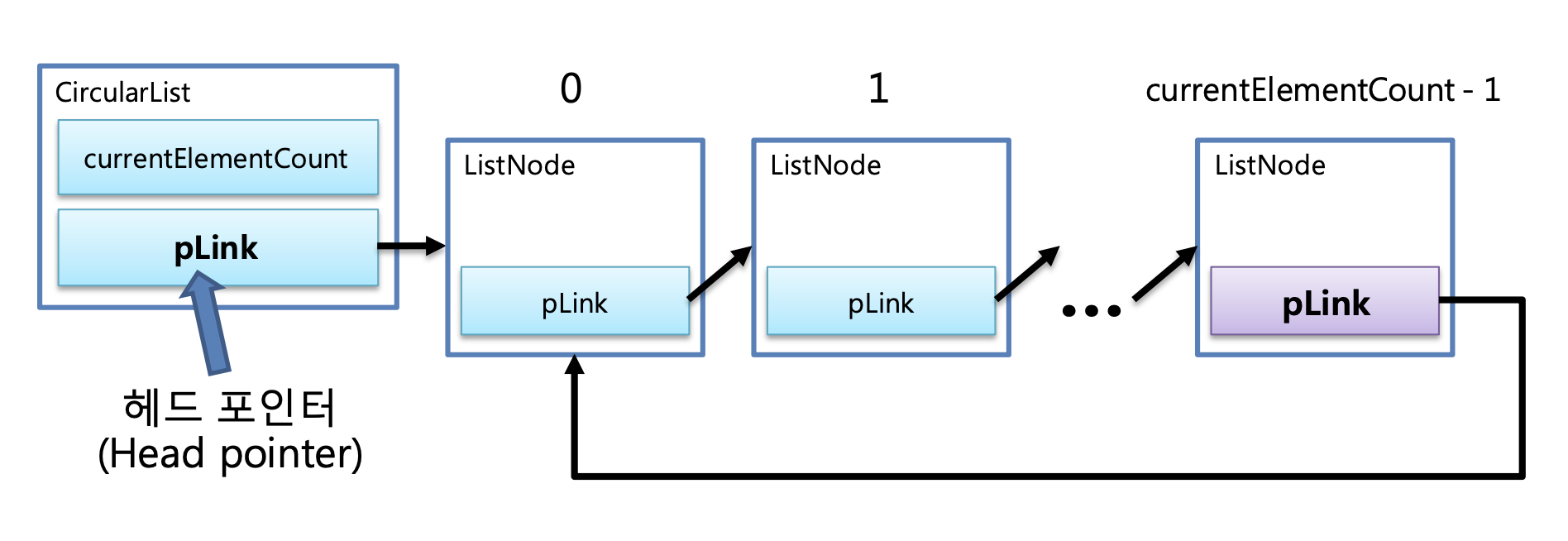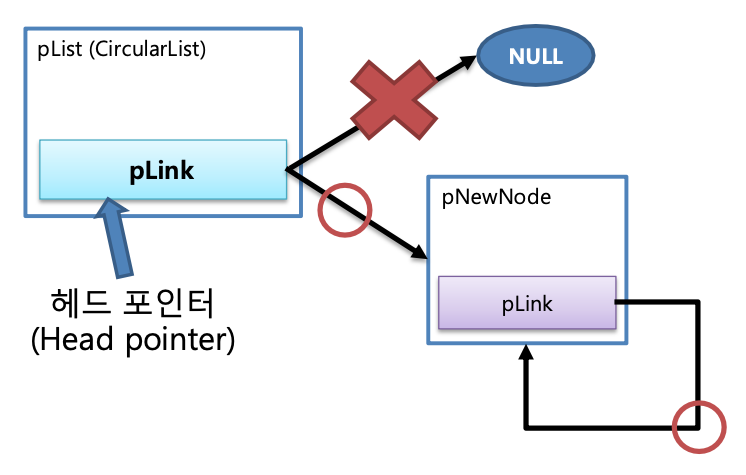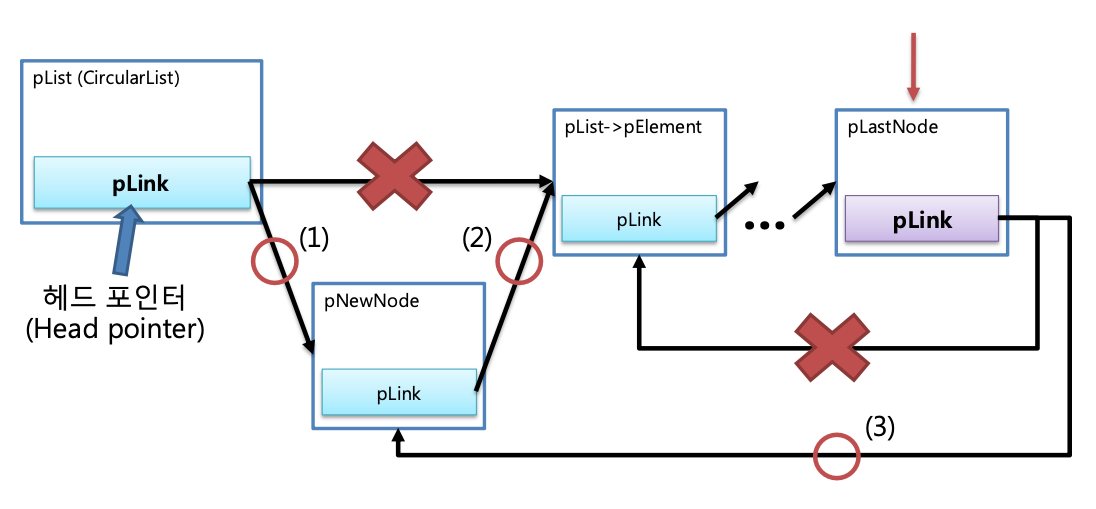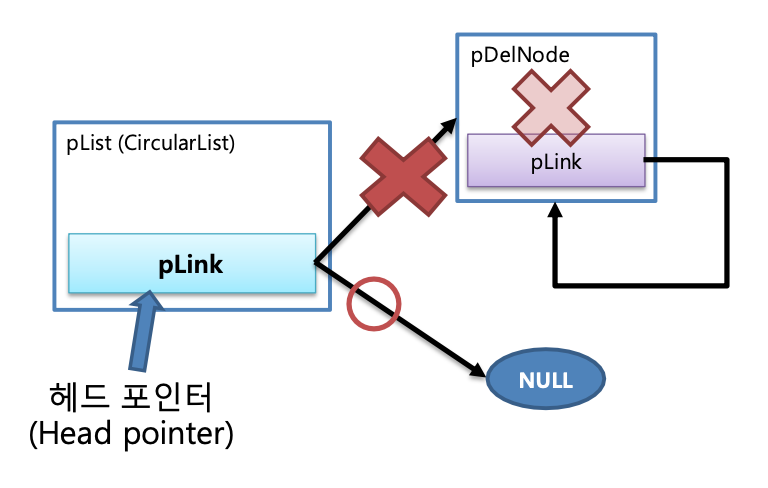특징
- 순환 구조

- 헤드포인터와 마지막 노드의 pLink가 가리키는 곳이 모두 첫번째 노드
- 원소가 1개일 경우 첫번째 노드의 pLink는 자기 자신(첫번째 노드)을 가리킴
- 첫번째 포지션에 노드 추가 시 마지막 노드의 pLink를 수정해줘야 함
- 첫번째 노드 삭제 시 헤드포인터를 수정해줘야 함
- 원소가 1개일 경우 헤드포인터가 NULL을 가리키도록 함
- 원소가 1개이상일 경우 헤드포인터는 현재 첫번째 노드의 pLink를 가리키도록 함
장점
- 헤드가 아닌 테일 포인터를 둘 경우 처음과 끝에 노드를 추가하는 것이 용이
- 마지막 노드 = 테일, 첫 노드 = 테일의 pLink로 접근 가능
단점
- 동적 할당, 포인터 연산 등으로 구현과 관리가 어려움
- 포인터의 사용으로 저장 공간의 낭비가 있음
구현
1. circularlist.c
#include "circularlist.h"
CircularList *createCircularList(void)
{
CircularList *new;
new = calloc(1, sizeof(CircularList)); // 구조체 변수 (현재 원소 개수 - 0, headPtr - NULL) 초기화
if (!new)
return (NULL);
return (new);
}
// 원소 개수 == 0 (삽입 노드의 pLink = 자기 자신)

// 원소 개수 > 0 && 삽입하려는 위치 == 첫번째 (마지막 노드의 pLink = 삽입 노드)

// 원소 개수 > 0 && 삽입하려는 위치 != 첫번째

int addCLElement(CircularList *pList, int position, ListNode element)
{
ListNode *new; // 삽입 노드
ListNode *prev; // 삽입 노드를 연결 할 이전 노드
ListNode *last; // 마지막 노드
if(!pList || position < 0 || position > pList->currentElementCount) // 에러 처리
return (FALSE);
new = malloc(sizeof(ListNode)); // 새 노드 할당
if (!new)
return (FALSE);
*new = element; // 정보 저장
prev = pList->headPtr;
if (position == 0) // 삽입하려는 위치가 첫번째일 경우
{
if (pList->currentElementCount == 0) // 현재 원소 개수가 0개일 때
{
new->pLink = new; // 삽입 노드의 pLink를 자기 자신으로
pList->headPtr = new; // headPtr의 pLink를 삽입 노드로
}
else // 현재 원소 개수가 1개 이상일 때
{
last = prev;
while (last->pLink != pList->headPtr) // 노드의 pLink가 headPtr이 가리키는 노드와 같을 경우 마지막 노드이므로 반복문 탈출
last = last->pLink; // 마지막 노드까지 last 이동
new->pLink = prev; // 삽입 노드의 pLink를 headPtr이 가리키고 있던 첫번째 노드에 연결
last->pLink = new; // 마지막 노드의 pLink를 삽입 노드에 연결
pList->headPtr = new; // headPtr을 삽입 노드에 연결
}
}
else // 삽입하려는 위치가 첫번째가 아닐 경우
{
while (--position > 0) // 삽입 위치 직전까지 prev 이동
prev = prev->pLink;
new->pLink = prev->pLink; // 삽입 노드의 pLink를 prev의 pLink에 연결
prev->pLink = new; // prev의 pLink에 삽입 노드를 연결
}
pList->currentElementCount++; // 현재 원소 개수 갱신
return (TRUE);
}// 원소 개수 == 1

// 원소 개수 > 1 && 제거 노드 위치 != 첫번째

int removeCLElement(CircularList* pList, int position)
{
ListNode *remove; // 제거 노드
ListNode *prev; // 제거 노드의 이전 노드
ListNode *last; // 마지막 노드
if (!pList || position >= pList->currentElementCount || position < 0) // 에러 처리
return (FALSE);
prev = pList->headPtr;
if (position == 0) // 제거 노드 위치가 첫번째일 경우
{
remove = prev; // 제거 노드 정보 저장
if (pList->currentElementCount == 1) // 현재 원소 개수가 1개일 때
pList->headPtr = NULL; // headPtr NULL에 연결
else // 현재 원소 개수가 1개 이상일 때
{
last = prev; // 마지막 노드
while (last->pLink != pList->headPtr) // 노드의 pLink가 headPtr이 가리키는 노드와 같을 경우 마지막 노드이므로 반복문 탈출
last = last->pLink; // 마지막 노드까지 last 이동
pList->headPtr = remove->pLink; // headPtr을 제거 노드의 pLink(현 두번째 노드)에 연결
last->pLink = remove->pLink; // 마지막 노드의 pLink를 제거 노드의 pLink(현 두번째 노드)에 연결
}
}
else // 제거 노드 위치가 첫번째가 아닐 경우
{
while (--position > 0) // 제거 위치 직전까지 prev 이동
prev = prev->pLink;
remove = prev->pLink; // 제거 노드 정보 저장
prev->pLink = remove->pLink; prev의 pLink에 제거 노드의 pLink를 연결
}
free(remove); // 제거 노드 할당 해제
pList->currentElementCount--; // 현재 원소 개수 갱신
return (TRUE);
}
ListNode *getCLElement(CircularList *pList, int position)
{
ListNode *ret;
if (!pList || position < 0 || position > pList->currentElementCount) // 에러 처리
return (FALSE);
ret = pList->headPtr;
while (position-- > 0) // 반환 위치까지 ret 이동
ret = ret->pLink;
return (ret);
}
int getCircularListLength(CircularList *pList)
{
return (pList->currentElementCount);
}
void displayCircularList(CircularList *pList)
{
ListNode *cur;
int i;
if (!pList) // 에러 처리
{
printf("No List\n");
return ;
}
printf("(1) Current Element count: %d\n", pList->currentElementCount);
if (pList->currentElementCount == 0)
printf("(2) Element: No Element\n\n");
else
{
printf("(2) Element\n");
cur = pList->headPtr;
for (i = 0; i < pList->currentElementCount; i++)
{
printf("[%d]: %d", i, cur->data);
if (i != pList->currentElementCount - 1)
printf(", "); // 마지막 노드 제외 쉼표 출력
cur = cur->pLink;
}
printf("\n\n");
}
}
void clearCircularList(CircularList* pList)
{
ListNode* node;
ListNode* tmp;
if (pList->currentElementCount == 0)
return ;
node = pList->headPtr;
while (pList->currentElementCount-- > 0) // 현재 원소 개수만큼
{
tmp = node->pLink; // 현재 노드의 다음 노드 저장을 위한 임시 변수
free(node); // 현재 노드 할당 해제
node = tmp; // 이전에 저장해 놓은 임시 변수 값을 가져와 연속적으로 리스트 순회
}
pList->headPtr = NULL; // 할당 해제 된 메모리에 접근하지 않도록 NULL처리
pList->currentElementCount = 0; // 현재 원소 개수 초기화
}
void deleteCircularList(CircularList *pList)
{
clearCircularList(pList); // clear를 통해 리스트 내부 모든 노드 할당 해제
free(pList); // 리스트 구조체 할당 해제
}2. circularlist_main.c
#include "circularlist.h"
int main(void)
{
CircularList *pList;
ListNode *node;
ListNode ListNode;
int loop;
int opt;
int position;
pList = NULL;
while (loop)
{
printf("[1] Create [2] Add [3] Remove [4] Get Element [5] Length [6] Display [7] Clear [8] Delete [9] Exit ");
scanf("%d", &opt);
switch (opt)
{
case 1:
pList = createCircularList();
if (pList)
printf("Create Circular List: Success\n\n");
else
printf("Create Circular List: Failed\n\n");
break;
case 2:
printf("Position: ");
scanf("%d", &position);
printf("Data: ");
scanf("%d", &ListNode.data);
if (addCLElement(pList, position, ListNode))
{
printf("Add: Success\n\n");
displayCircularList(pList);
}
else
printf("Add: Failed\n\n");
break;
case 3:
printf("Position: ");
scanf("%d", &position);
if (removeCLElement(pList, position))
{
printf("Remove: Success\n\n");
displayCircularList(pList);
}
else
printf("Remove: Failed\n\n");
break;
case 4:
printf("Position: ");
scanf("%d", &position);
node = getCLElement(pList, position);
if (node)
printf("[%d]: %d\n\n", position, node->data);
else
printf("Failed\n\n");
break;
case 5:
printf("Length: %d\n\n", getCircularListLength(pList));
break;
case 6:
displayCircularList(pList);
break;
case 7:
if (!pList)
printf("Clear: Failed\n\n");
else
{
clearCircularList(pList);
printf("Clear: Success\n\n");
}
break;
case 8:
if (!pList)
printf("Delete: Failed\n\n");
else
{
deleteCircularList(pList);
pList = NULL;
printf("Delete: Success\n\n");
}
break;
case 9:
loop = 0;
break;
default:
printf("Please Enter a Valid Option\n\n");
break;
}
}
}3. circularlist.h
#ifndef _CIRCULARLIST_
#define _CIRCULARLIST_
#include <stdio.h>
#include <stdlib.h>
typedef struct ListNodeType
{
int data;
struct ListNodeType* pLink; // 다음 노드 연결을 위한 포인터
} ListNode;
typedef struct CircularListType
{
int currentElementCount; // 현재 삽입된 원소의 개수
ListNode *headPtr; // 헤드 포인터
} CircularList;
CircularList* createCircularList();
int addCLElement(CircularList* pList, int position, ListNode element);
int removeCLElement(CircularList* pList, int position);
ListNode* getCLElement(CircularList* pList, int position);
int getCircularListLength(CircularList* pList);
void displayCircularList(CircularList *pList);
void clearCircularList(CircularList* pList);
void deleteCircularList(CircularList* pList);
#endif
#ifndef _COMMON_LIST_DEF_
#define _COMMON_LIST_DEF_
#define TRUE 1
#define FALSE 0
#endif